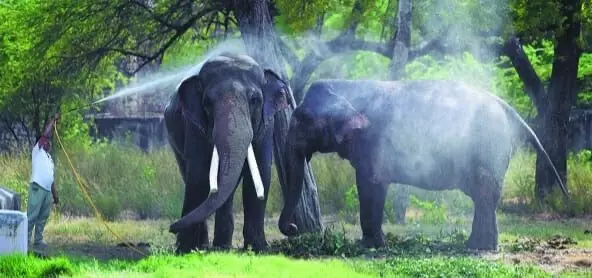Delhi Zoo implements ayurvedic methods to safeguard animals during monsoon
As the monsoon season sets in, Delhi Zoo is taking innovative steps to ensure the health and safety of its animal
By Newsmeter Network
New Delhi: Delhi Zoo authorities are using ayurvedic methods, including neem oil, turmeric and quicklime, to keep the animals healthy and free from bacterial and viral infections during the rainy season.
As the monsoon season sets in, Delhi Zoo is taking innovative steps to ensure the health and safety of its animals by incorporating traditional ayurvedic methods.
"The monsoon has entered the capital and we have to take all necessary measures to keep the animals healthy and safe during this season. We will use some Indian home remedies like neem oil, which will help protect the animals from common biting insects, including mosquitoes, biting midges and fleas," Delhi Zoo Director Sanjeet Kumar told PTI.
Neem oil acts as an herbal disinfectant and fly repellent, said Kumar, turmeric, known for its anti-inflammatory and healing properties, will be used to treat itchy skin conditions, infections and wounds. Turmeric dust will be applied to lesions and foot sores to expedite healing, he said.
Heavy rains often lead to waterlogging in certain parts of the zoo which create breeding grounds for mosquitoes. To counter this, quicklime (chuna) will be sprinkled in these areas to prevent mosquito proliferation.
"We are using quicklime in waterlogged spots to stop the growth of mosquitoes and keep our animals safe," the official said.
After the heavy rains that lashed the national capital on Friday, recording 228.1 mm of rainfall in just 24 hours — the highest in June since 1936 — the Delhi Zoo was also affected.
A power failure occurred when floodwaters breached the zoo’s boundary wall from the Sundernagar side, inundating the substation area and causing damage to the transformer.
This incident affected animal enclosures, administrative offices and staff quarters. Referring to this situation, Kumar said that measures have been taken to prevent a recurrence.
"The broken boundary is being repaired and barriers are being installed to prevent water backflow, ensuring water does not reach the animal enclosures," he said.
Additional measures include providing elevated platforms in areas prone to water accumulation, ensuring animals have dry spots to rest.
"The director also mentioned that we will purchase an additional generator dedicated to essential uses such as gate operation, Wi-Fi, control room, CCTV operations and animal enclosures for water pumping during rainy periods when electricity is cut off," said Kumar.
The official also said that Delhi Zoo presently has two generators: one for the animal hospital and another for operational needs throughout the facility, with the third generator to be allocated accordingly.
He emphasised the importance of preparing for rain-related health issues by stocking necessary medicines.
The National Zoological Park, also known as Delhi Zoo, is situated in a 176-acre area under the central government's jurisdiction.